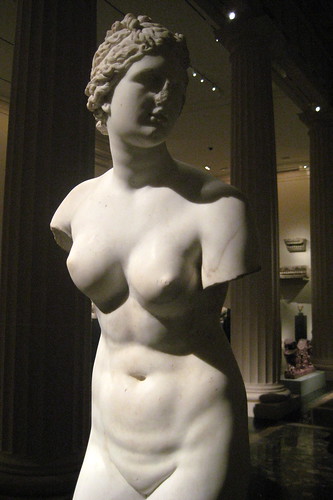NYC – Metropolitan Museum of Art: Marble statue of Aphrodite
Some cool Museums images:
NYC - Metropolitan Museum of Art: Marble statue of Aphrodite

Image by wallyg
Marble statue of Aphrodite
Roman, Imperial period, 1st or 2nd century, A.D.
Copy of Greek statue of the 3rd or 2nd century B.C.
The lower legs have been restored with casts taken from the Roman copy in Florence known as the Medici Venus
The goddess of love is shown as though surprised at her bath. Originally, her arms reached forward to shield her breasts and pubis in a gesture that both concealed and accentuated her sexuality.
Statues of Aphrodite in the nude proliferated during the Hellinistic period. All were inspired to some degree by the Aphrodite of Cnidus (Knidos) by Attic sculptor Praxiteles (c.350 BC). That statue, the first major Greek work to show the goddess without clothing, was celebrated throughout antiquity as one of the seven wonders of the world. This particular work has the same gesture of modesty as the Knidos and is very similar to another Roman copy, the so called Medici Venus, which has stood in the Uffizi Gallery in Florence since 1688. During the eighteenth and nineteenth centuries it was considered one of the finest ancient works in existence.
Purchase, 1953
**
The April 20, 2007 unveiling of the 30,000 square foot Greek and Roman Galleries concluded a 15-year project and returned thousands of works from the Museums permanent collection to public view. Over 5,300 objects, created between about 900 B.C. and the early fourth century A.D., are displayed, tracing the parallel stories of the evolution of Greek art in the Hellenistic period and the arts of southern Italy and Etruria and culminating in the rich and varied world of the Roman Empire from from the Late Republican period and the Golden Age of Augustuss Principate to the conversion of Constantine the Great in A.D. 312. The centerpiece of the new installation is the Leon Levy and Shelby White Court, a monumental, peristyle cour court with a soaring two-story atrium that links the various galleries and themes.
The Metropolitan Museum of Art's permanent collection contains more than two million works of art from around the world. It opened its doors on February 20, 1872, housed in a building located at 681 Fifth Avenue in New York City. Under their guidance of John Taylor Johnston and George Palmer Putnam, the Met's holdings, initially consisting of a Roman stone sarcophagus and 174 mostly European paintings, quickly outgrew the available space. In 1873, occasioned by the Met's purchase of the Cesnola Collection of Cypriot antiquities, the museum decamped from Fifth Avenue and took up residence at the Douglas Mansion on West 14th Street. However, these new accommodations were temporary; after negotiations with the city of New York, the Met acquired land on the east side of Central Park, where it built its permanent home, a red-brick Gothic Revival stone "mausoleum" designed by American architects Calvert Vaux and Jacob Wrey Mold. As of 2006, the Met measures almost a quarter mile long and occupies more than two million square feet, more than 20 times the size of the original 1880 building.
In 2007, the Metropolitan Museum of Art was ranked #17 on the AIA 150 America's Favorite Architecture list.
The Metropolitan Museum of Art was designated a landmark by the New York City Landmarks Preservation Commission in 1967. The interior was designated in 1977.
National Historic Register #86003556
British Museum Great Court (#229)

Image by Christopher Chan
The court has a tessellated glass roof by Foster and Partners (Architects) and Buro Happold (Engineers) covering the entire court and surrounds the original circular British Museum Reading Room in the centre, now a museum. (Wikipedia)
Top Explore Position : 229
Buy Print (Starting at: US.74)
NYC - Metropolitan Museum of Art: Winslow Homer's Eagle Head, Manchester, Massachusetts (High Tide)

Image by wallyg
Eagle Head, Manchester, Massachusetts (High Tide)
1870
Winslow Homer (1836-1910)
Oil on canvas; 26 x 38 in. (66 x 96.5 cm)
When this work was first exhibited in New York in 1870, contemporary critics focused on Homer's technical shortcomings, his subject matter, and the lack of propriety in the bathers' costumes. The discomforting character of the painting, however, went unnoticed by all but a few. Three women bathers, physically close yet estranged and anonymous, are represented with a little dog on a beach. A distant sailboat, birds in flight, and small figures on the shore at the left , add minute, anecdotal notes of interest to an otherwise desolate scene. The unembellished starkness of the image, and the harsh light and long shadows intensify the disquieting quality of the painting.
Gift of Mrs. William F. Milton, 1923 (23.77.2)
**
The Metropolitan Museum of Art's permanent collection contains more than two million works of art from around the world. It opened its doors on February 20, 1872, housed in a building located at 681 Fifth Avenue in New York City. Under their guidance of John Taylor Johnston and George Palmer Putnam, the Met's holdings, initially consisting of a Roman stone sarcophagus and 174 mostly European paintings, quickly outgrew the available space. In 1873, occasioned by the Met's purchase of the Cesnola Collection of Cypriot antiquities, the museum decamped from Fifth Avenue and took up residence at the Douglas Mansion on West 14th Street. However, these new accommodations were temporary; after negotiations with the city of New York, the Met acquired land on the east side of Central Park, where it built its permanent home, a red-brick Gothic Revival stone "mausoleum" designed by American architects Calvert Vaux and Jacob Wrey Mold. As of 2006, the Met measures almost a quarter mile long and occupies more than two million square feet, more than 20 times the size of the original 1880 building.
In 2007, the Metropolitan Museum of Art was ranked #17 on the AIA 150 America's Favorite Architecture list.
The Metropolitan Museum of Art was designated a landmark by the New York City Landmarks Preservation Commission in 1967. The interior was designated in 1977.
National Historic Register #86003556
No comments:
Post a Comment